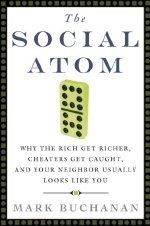I'm always surprised to find scientists whose work I respect having religious beliefs. It seems, from an essay by Carl Zimmer in today's New York Times, that mathematical biologist Martin Nowak of Harvard University may be one such scientist believer. As Zimmer quotes Nowak,
Like mathematics, many theological statements do not need scientific confirmation. Once you have the proof of Fermat’s Last Theorem, it’s not like we have to wait for the scientists to tell us if it’s right.
Nowak has done lots of great work on the logic of social behavior and cooperation in biology, not only among humans, but among may other organisms. It's brilliant work, and I've written about this field in the past. If you think we humans are really special because of our ability to cooperate, think again; single-celled bacteria manage many of the same tricks (which I think really brings home the point that some social phenomena have much more to do with the logic of collective organization than with the "specialness" of individual human beings).
Still, I find Nowak's comment on theology quite striking, and really hard to understand. (And obviously, I don't know the complete context in which he said it.) Does he believe that principles of religious belief can be established with the same kind of mathematical certainty as Fermat's last theorem, or any other mathematical theorem? His argument seems to have a devious logic.
Mathematical certainty is of a different order from anything requiring empirical confirmation; I believe in Pythagoras' Theorem in plane geometry because of mathematical proof, not empirical facts (that it works in practice merely shows how well plane geometry fits our world of ordinary experience). Quite reasonably, therefore, Nowak argues that scientists don't go demanding empirical evidence for mathematical assertions, the truth of which has been established by logic (if one already accepts the beginning assumptions). But then comes the punchline -- so why should scientists demand evidence for religious assertations?
Well the problem, obviously, is that religious beliefs aren't established by any appeal to logic, but are taken on faith. They aren't like mathematics, and so the comparison is just irrelevant. It seems as if Nowak is implying that some theological statements can be proven by pure logic, but which ones? I'd love to see some examples.
All this brings to mind a fascinating novel I just read, A Certain Ambiguity, by Gaurav Suri and Hartosh Singh Bal (I have a short review of it forthcoming in New Scientist). In the novel, an Indian mathematician Vijay Sanhi gets arrested in New Jersey under archaic laws against "blasphemy," when he publically doubts the truths of Christianity. He must defend himself before a Judge who is himself a committed Christian. Sahni tries to argue to the judge that religious certainty never approaches the same level as mathematical certainty, and illustrates the nature of mathematical reasoning by showing how geometric truths (such as the Pythagorean theorem) can be established from a handful of "self evident" axioms and pure logic.
To this demonstration, the Judge quickly responds that the same is true in Christianity:
I start with the "simple fact" that everything in the Universe must be created by something; it cannot come into being out of nothing. ... ; hence, the first something must have been created by a being that was always there, a being that could create something from nothing, and a being that lived before time started. Humans have just given that being a name; we call Him God.
To which Sanhi replies:
The problem is I do not believe your underlying "simple fact" that everything in the universe must have been created by something... Everywhere I look, life is full of cycles.. Or I could equally well claim that the "first thing" always existed... You assumption that everything must have a cause of creation applies to the world of sense experience. In this realm I will agree with you that your "simple fact" of causality is self-evident. But you have extended the "simple fact" beyond the world of sense experience to something that is supposed to transcend it. You have applied an experiential notion beyond all possible experience, as well as beyond the limits for which there are any guarantees that our sensory perceptions are reliable. So, yes, Judge, I disbelieve your underlying simple fact, and hence I disbelieve your conclusion that God exists.
Curiously, the Zimmer article also quotes another well-known scientist believer, biologist Francis Collins, director of the National Human Genome Research Institute. But Collins and Nowak seem to disagree with one another. While Collins claims that "Selfless altruism presents a major challenge for the evolutionist," a point I've argued against in The Social Atom, and in this blog, and elsewhere, Nowak seems to think there's no big problem. “The current theory," he says, "can certainly explain a population where some people act extremely altruistically."
But so what. People disagree, and people are all over the board on this religion versus science argument, and what it comes down to, it seems to me, is a point made very well by Sam Harris in The End of Faith -- that those motivated by religion and faith seem to have marked off a special corner of life in which the ordinary laws of thinking and evidence just aren't supposed to apply. For those persuaded by religious faith, the world seems to fall into two disjoint parts -- one in which the search for evidence and application of reason is the only known method for gaining sure knowledge, and the other in which the need for evidence is wilfully suspended:
Tell a devout Christian that his wife is cheating on him, or that frozen yogurt can make a man invisible, and he is likely to require as much evidence as anyone else, and to be persuaded only to the extent that you give it. Tell him that the book he keeps by his bed was written by an invisible deity who will punish him with fire for eternity if he fails to accept its every incredible claim, and he seems to require no evidence whatsoever.




